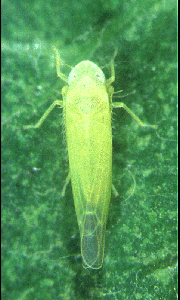Subfamily Typhlocybinae: Tribe Typhlocybini

Edwardsiana froggatti (Baker),
The Apple Leafhopper
The Australian and New Zealand representatives of this tribe are introductions, mainly from Europe or North America (Fletcher, et al. 1996). The European elm leafhopper (Ribautiana ulmi) is widespread in the cooler parts of Australia and causes extensive chlorotic mottling on its hosts which reduces the value of elm trees as ornamentals (Fletcher and Williams 1987). The Australian apple leafhopper, Edwardsiana froggatti, is a pest of the pome fruit industry, causing chlorotic mottling and leaf drop in apple and pear orchards. E. froggatti, which is also found in New Zealand [update: 12.ii.2001], is known as the canary fly in Tasmania because of its bright yellow colouring. Traditional use of broad-spectrum insecticides for codling moth control has kept apple leafhopper in check as well, but the reduction in use of such environmentally harmful insecticides in favour of more targetted IPM for control of major pests is leading to a resurgence of problems with secondary pests such as apple leafhoppers.
- Species of Typhlocybini known to occur in Australia
- Link to keys for New Zealand Typhlocybini
- Species of Typhlocybini known to occur in eastern Indonesia
- Return to previous key page
- Restart key
Species of Typhlocybini known to occur in Australia
Many undescribed species of Typhlocybinae are known to occur in Australia. ABRS funding has allowed taxonomic research on this subfamily to be undertaken and this list will therefore be updated as the descriptions of the new species are published.
Genus Edwardsiana ZachvatkinEdwardsiana Zachvatkin 1929: 262 |
|
Edwardsiana froggatti (Baker), the apple leafhopper ("canary fly" in Tasmania) Typhlocyba crataegi Dominique 1902: 211, preoccupied by Typhlocyba crataegi Douglas (1876) Known hosts: Malus (Rosaceae) (Froggatt 1918) Note: Nast (1972) proposed that this species was a
synonym of E. crataegi (Douglas). This synonymy appears to
have been based on a publication by Günthart (1971)
who showed that the two forms were capable of interbreeding in the laboratory. However,
while males of E. froggatti were able to couple with females of E. crataegi,
the longer apical aedeagal appendages of E. crataegi meant that the reverse
combination was impossible. It is probable that the interbreeding that was observed was a
laboratory artefact and that such behaviour may not occur naturally. The synonymy was not
accepted by Knight (1976), Wise (1977) nor Day & Fletcher (1994). |
NSW, Tas, WA, NZ, Europe, N. America [update: WA added 11.xi.2003] |
Genus Ribautiana ZachvatkinRibautiana Zachvatkin 1947: 113 |
|
Ribautiana ulmi (Linnaeus), the European elm leafhopper Cicada ulmi Linnaeus 1758:
439 Known hosts: Ulmus (Ulmaceae), Alnus (Betulaceae), Tilia (Tiliaceae),
Quercus (Fagaceae), Buxus (Buxaceae), bramble (Rosaceae) (Ribaut 1936) |
NSW, Vic, ACT, Tas, Europe, North America |
